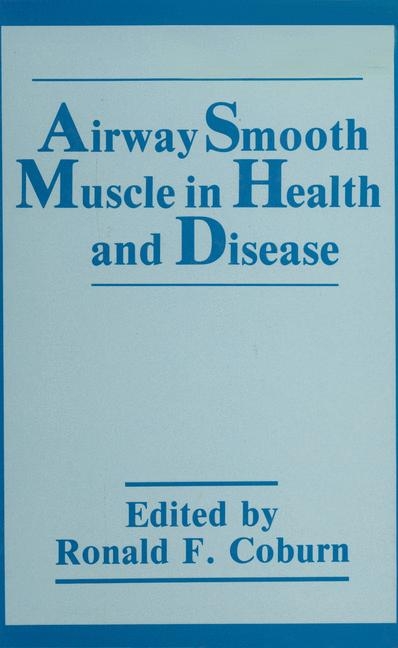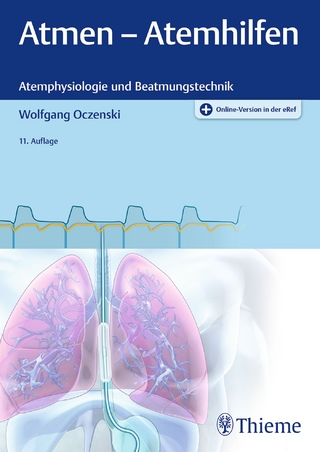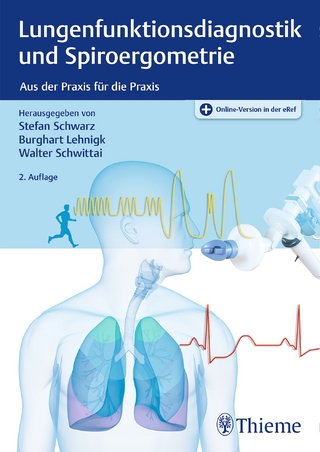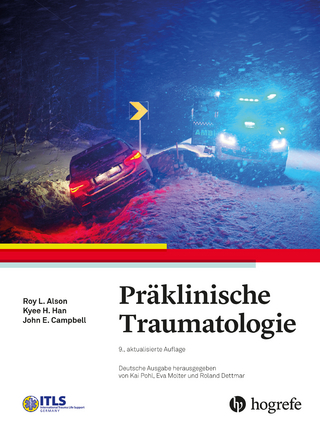
Airway Smooth Muscle in Health and Disease
Kluwer Academic/Plenum Publishers (Verlag)
978-0-306-43120-3 (ISBN)
- Titel ist leider vergriffen;
keine Neuauflage - Artikel merken
1 Structure of Airway Smooth Muscle and Its Innervation.- I. Nerve Supply to Trachea and Bronchi.- II. Structure of the Musculature.- III. Nerve-Mediated Responses.- IV. Distribution of Intramuscular Nerves.- V. Histochemical Types of Nerve Fibers.- VI. Density of Innervation.- VII. Types of Nerve Endings.- VIII. Neuromuscular Junctions.- IX. Smooth Muscle Cells.- X. Gap Junctions.- XI. References.- 2 Integration of Neural Inputs in Peripheral Airway Ganglia.- I. Introduction.- II. Neural Input to Airway Smooth Muscle: How the System Is Wired.- III. Basic Properties of Peripheral Airway Ganglia.- IV. Circuitry of Ferret Paratracheal Ganglion Neurons.- V. Integration and Modulation of Neural Inputs.- A. Peripheral Airway Ganglia.- B. Neuromuscular Junction.- VI. References.- 3 Nervous Receptors in the Tracheobronchial Tree: Airway Smooth Muscle Reflexes.- I. Introduction.- II. Pulmonary Stretch Receptors.- A. Reflex Actions on Airway Smooth Muscle.- B. Other Reflex Actions.- III. Rapidly Adapting (Irritant) Receptors.- A. Reflex Actions on Airway Smooth Muscle.- B. Other Reflex Actions.- IV. C-Fiber Receptors.- A. Reflex Actions on Airway Smooth Muscle.- B. Other Reflex Actions.- V. Local (Axon) Reflex Actions.- VI. Neuroepithelial Bodies.- VII. Other Reflex Actions on Airway Smooth Muscle.- A. Reflexes from the Upper Respiratory Tract.- B. Bronchomotor Reflexes from Other Sites.- VIII. Motor Pathways to Tracheobronchial Smooth Muscle.- IX. References.- 4 Polypeptide-Containing Neurons and Their Function in Airway Smooth Muscle.- I. Neuropeptides as Physiological Regulators.- II. Autonomic Innervation of Airways: Peptidergic Neurons.- III. Identification, Localization, and Distribution of Peptidergic Neurons.- IV. Families of Neuropeptides.- V. Peptides as Neurotransmitters and Neuromodulators.- A. When Are Neuropeptides Neurotransmitters?.- B. Neurotransmitter versus Endocrine and Paracrine Secretions.- C. Coexistence of Peptides and Other Neurotransmitters.- D. How Neuropeptides May Influence Respiratory Function.- E. Bronchoactive Peptides.- F. Interactions between Neuropeptides and Classic Neurotransmitters.- VI. Neuropeptide Receptors on Smooth Muscle.- A. VIP and PHI/PHM.- B. Substance P and Other Neurokinins.- C. Atrial Natriuretic Peptide.- VII. Mechanisms of Bronchial Relaxation and Constriction by Neuropeptides.- VIII. Importance of Airway Epithelium in Responses to Bronchoactive Agents.- IX. Neuropeptides as Physiological Regulators of Airway Smooth Muscle Function.- A. VIP.- B. Substance P and Other Neurokinins.- X. Regulating the Regulators: Enzymatic Degradation of Airway Peptides.- XI. Neuropeptides in Airway Disease.- A. VIP in the Pathogenesis of Airway Disease.- B. Neurokinins P and Other Sensory Neuropeptides.- XII. Conclusion.- XIII. References.- 5 Cell-Surface Receptors in Airway Smooth Muscle.- I. Introduction.- II. Indirect Regulation of Airway Smooth Muscle.- III. Airway Receptors and Disease.- IV. Autonomic Receptors.- A. Autonomic Control of Airways.- B. ?-Adrenoceptors.- C. ?-Receptor Subtypes.- D. ?-Receptor Dysfunction in Asthma.- E. ?-Adrenoceptors.- F. ?-Receptor Subtypes.- G. ?-Receptors in Asthma.- H. Cholinergic Receptors.- I. Muscarinic Receptor Subtypes.- V. Neuropeptide Receptors.- A. VIP Receptors.- B. Tachykinin Receptors.- C. Other Neuropeptide Receptors.- VI. Mediator Receptors.- A. Histamine Receptors.- B. Prostanoid Receptors.- C. Leukotriene Receptors.- D. Platelet Activating Factor Receptors.- E. Adenosine Receptors.- F. Bradykinin Receptors.- VII. Conclusions.- VIII. References.- 6 Cellular Control Mechanisms in Airway Smooth Muscle.- I. Introduction.- II. Biochemistry of Smooth Muscle Contraction.- III. Physiological Experiments on Myosin Phosphorylation.- IV. Other Possible Regulatory Mechanisms.- V. Cyclic Nucleotide Effects.- VI. Myosin Phosphorylation by Other Protein Kinases.- VII. Myosin Phosphatases.- VIII. Summary.- IX. References.- 7 Transduction and Signaling in Airway Smooth Muscle.- I. Introduction.- II. Control of Second-Messenger Production by Guanine Nucleotide-Binding Proteins.- III. Inositol Phospholipid Metabolism.- A. Hydrolysis of PI-4,5-P2 by Inositol Phospholipid-Specific Phospholipase C and Ca2+ Release.- B. Formation of Diacylglycerol, Activation of Protein Kinase C, and Modulation of PI-4,5-P2 Hydrolysis.- C. Metabolism of Inositol Phosphates.- D. Synthesis of Phosphatidylinositol.- E. Rates of Synthesis of Inositol Phospholipids.- F. Compartmentation of Inositol Phospholipids.- G. Other Reactions of Inositol Phospholipid Metabolism.- H. ATP Utilization by Inositol Phospholipid Metabolism.- I. Considerations for Labeling Methods in Assessment of Inositol Phospholipid Metabolism.- IV. Stale of Knowledge in Airway Smooth Muscle.- V. Summary.- VI. References.- 8 Electrical Properties of Airway Smooth Muscle.- I. Introduction.- II. Technical Problems.- III. Membrane Potential and Spontaneous Electrical Activity.- IV. Evoked Action Potentials.- V. Response to Excitatory Agents.- VI. Response to Inhibitory Agents.- VII. Summary.- VIII. References.- 9 Ion Channels in Airway Smooth Muscle.- I. Introduction.- II. Ion Channels.- III. Patch-Clamp Techniques.- IV. Potassium Channels in Airway Smooth Muscle.- V. Calcium Channels in Airway Smooth Muscle.- VI. Functional Characteristics of Ion Channels in Airway Smooth Muscle.- VII. References.- 10 Coupling Mechanisms in Airway Smooth Muscle.- I. Introduction.- II. Pharmacomechanical Coupling Mechanisms.- III. Electromechanical Coupling Mechanisms during Muscarinic Contractions.- IV. Coupling between Receptors, Channels, and Second-Messenger Systems.- V. Cytosolic Free Calcium Concentration.- VI. Modulation of Electromechanical and Pharmacomechanical Coupling Mechanisms.- VII. Summary.- VIII. References.- 11 Postulated Mechanisms Underlying Airway Hyperreactivity: Relationship to Supersensitivity.- I. Introduction.- II. Potential Mechanisms of Airway Hyperreactivity.- A. Dysfunction in Receptors.- B. Imbalance in Regulation of the Autonomic Nervous System.- C. Change in Electrophysiological Characteristics of Smooth Muscle Cells.- D. Abnormalities in Ca2+ Translocation and Handling.- E. Change in Airway Morphology/Geometry: Mechanical Factors.- F. Decreased Airway Caliber.- G. Increased Release of Mediators.- H. Epithelial Cell Damage or Dysfunction.- III. Inflammation.- IV. Summary.- V. References.- 12 Airway Epithelial Metabolism and Airway Smooth Muscle Hyperresponsiveness.- I. Introduction.- II. Epithelial Permeability.- III. Epithelial Mediator Release.- IV. Airway Inflammation.- A. Neutrophils.- B. Monocytes/Macrophages.- C. Mast Cells.- D. Eosinophils.- E. Platelets.- V. Viral Infection of Airway Epithelium.- A. Induction of Airway Inflammation.- B. Damage to Airway Epithelium.- C. Impaired ?-Adrenoceptor Function.- D. Induction of IgE Response.- E. Increased Release of Histamine by Mast Cells.- F. Induction of T-Lymphocyte Response.- G. Increased Sensitivity to the Bronchoconstncting Effects of Substance P.- VI. Sensory Nerve Products.- VII. Summary.- VIII. References.- 13 Airway Hyperreactivity: Relationship to Disease States.- I. Introduction.- II. Graded Dose-Response Curve.- III. Smooth Muscle Activation.- IV. Smooth Muscle Contraction.- V. Wall Thickness and Secretions.- VI. Summary.- VII. References.- 14 Current Concepts of the Pathophysiology of Allergic Asthma.- I. Introduction.- II. Allergic Asthma.- A. Diagnosis.- B. Epidemiology.- C. Natural History, Morbidity, and Mortality.- D. Inheritance.- III. Pathophysiology of Allergic Asthma.- A. Antigen Entry.- B. Pulmonary Mast Cells.- C. Mast Cell Stimulation and Mediator Release.- IV. Pathological Processes in Allergic Asthma.- A. Bronchospasm.- B. Mucosal Edema.- C. Mucus Secretion.- D. Late-Phase Reactions.- E. Desquamation of Surface Epithelium, Thickening of the Basement Membrane, and Goblet Cell Hyperplasia.- V. Airway Inflammation and Hyperreactivity.- VI. Other Modulators of Airway Responsiveness.- VII. Summary.- VIII. References.- 15 Exercise-Induced Bronchoconstriction.- I. Definition of Exercise-Induced Bronchoconstriction.- A. Response of Normal Subjects to Exercise.- B. Clinical Presentation of Exercise-Induced Bronchoconstriction.- II. Mechanism of Exercise-Induced Bronchoconstriction.- A. Heat and Water Exchange in Upper Airways.- B. Role of Minute Ventilation.- C. Consequence of Heat Loss and Water Loss.- III. Summary.- IV. References.
| Zusatzinfo | 334 p. |
|---|---|
| Verlagsort | New York |
| Sprache | englisch |
| Gewicht | 630 g |
| Themenwelt | Medizinische Fachgebiete ► Innere Medizin ► Pneumologie |
| Naturwissenschaften ► Biologie ► Biochemie | |
| ISBN-10 | 0-306-43120-3 / 0306431203 |
| ISBN-13 | 978-0-306-43120-3 / 9780306431203 |
| Zustand | Neuware |
| Haben Sie eine Frage zum Produkt? |
aus dem Bereich


